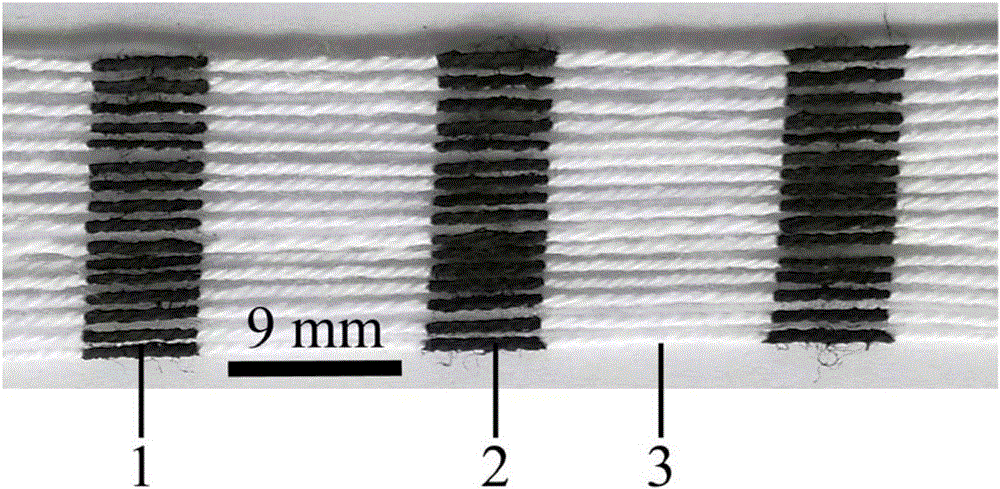Capillary micro-channel assistant wire base microfluidic bipolar electrode electrochemical luminescence device and application
A bipolar electrode and light-emitting device technology, which is applied in the direction of chemiluminescence/bioluminescence, and analysis by making materials undergo chemical reactions, can solve problems that have not been reported before, and achieve fast sample loading, good flexibility, and simple processing. Effect
- Summary
- Abstract
- Description
- Claims
- Application Information
AI Technical Summary
Problems solved by technology
Method used
Image
Examples
Embodiment 1
[0068] A preparation method of capillary microchannel-assisted line-based microfluidic bipolar electrode electrochemiluminescence device, comprising the following steps:
[0069] (1) Use Adobe Illustrate CS5 drawing software to design the size of the wire base electrode and the bare wire area of the patterned wire electrode, and then process it into a 300-mesh polyester stencil by Guangzhou Lianchang Printing Equipment Store;
[0070] (2) Take a hydrophilic white cotton thread ball (the thread diameter is about 0.5mm), cut out 16 lines with a length of 100mm with scissors; Flatly fixed on the smooth glass processing table, and the screen is attached to the line array;
[0071] (3) Conductive carbon paste (figure 1 shown).
[0072] From figure 1 It can be seen that the method of the present invention can be well processed into 16 patterned wire electrodes, each of which has 2 bare wire regions 3 (about 12 mm in length), 2 driving electrodes 1 (about 7 mm in length), and 1 b...
Embodiment 2
[0080] The application of the capillary microchannel-assisted line-based microfluidic device prepared in Example 1 in the electrochemiluminescence detection of TPA at the amphoteric electrode includes the following steps:
[0081] (a) Use alligator clips to connect the positive drive electrode and the negative drive electrode of the capillary microchannel auxiliary line-based microfluidic device to the positive and negative poles of a DC power supply (model PS-305D), respectively, and the power supply is turned off;
[0082] (b) Use a pipette gun to drop a certain volume of test solution near the port of the capillary microchannel, and wait for a few seconds to make the line between the driving electrodes and the capillary full of test solution. The test solution is PBS (0.1M) with a pH value of 6.9 to prepare a 10mM TPA solution and a 2.0mM Ru(bpy) 3 2+ The solutions are obtained by mixing in a volume ratio of 1:1.
[0083](c) Then put the bracket and the light-emitting dev...
Embodiment 3
[0090] 2 important factors (capillary microchannel length L CMC , driving voltage E tot ) for optimization
[0091] a) Preferred capillary microchannel length L CMC
[0092] (1) other conditions are the same as embodiment 2, i.e. T screen =17,L BPE = ~ 7mm; E tot =22V; V assay = 13-17 μL.
[0093] (2) Set up several experimental groups: capillary microchannel length L CMC Set to several different values (12mm, 16mm, 20mm, 24mm, 28mm).
[0094] (3) detection and analysis process are with embodiment 2, and experimental result is as follows Figure 6 shown.
[0095] It can be seen from the experimental results that the luminous intensity increases with the L CMC It is gradually enhanced when changing from 12mm to 24mm. The possible reason is that in the same E tot Under the condition, the longer capillary microchannel can load more test liquid, resulting in a larger internal electric field intensity, which leads to a larger potential difference between the two ends...
PUM
| Property | Measurement | Unit |
|---|---|---|
| length | aaaaa | aaaaa |
| length | aaaaa | aaaaa |
Abstract
Description
Claims
Application Information
 Login to View More
Login to View More - R&D
- Intellectual Property
- Life Sciences
- Materials
- Tech Scout
- Unparalleled Data Quality
- Higher Quality Content
- 60% Fewer Hallucinations
Browse by: Latest US Patents, China's latest patents, Technical Efficacy Thesaurus, Application Domain, Technology Topic, Popular Technical Reports.
© 2025 PatSnap. All rights reserved.Legal|Privacy policy|Modern Slavery Act Transparency Statement|Sitemap|About US| Contact US: help@patsnap.com



